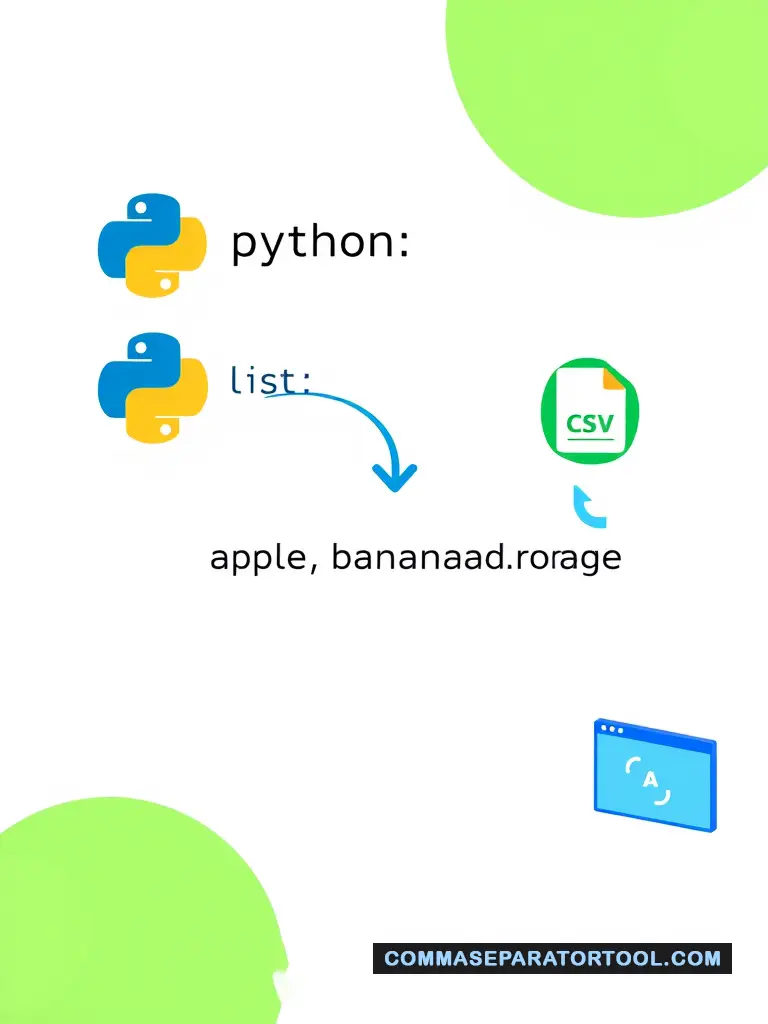“Convert Python list to comma separated string with join() for ‘a,b,c’, map() for integers, or online tools like Online Python List to a Comma-Separated String Converter—perfect for CSV formatting or API data from lists like [‘x’,’y’].”
Working with Python is a joy for developers because of its simplicity and flexibility, but handling data formats can sometimes present challenges. Have you wondered how to transform a Python list to comma separated string quickly and efficiently? Whether you’re a Python developer, data scientist, or web developer working with APIs or datasets, mastering this skill is highly beneficial.
This blog provides you with a comprehensive guide on how to convert Python list to comma separated string, whether through coding or an online tool. You’ll also learn how to optimize your workflow using Python list to comma separated string Converter Tool for maximum efficiency.
Table of Contents
Why Convert a Python List to Comma Separated String?
Before we dig into the “how,” let’s understand the “why.” Converting a list to a comma-separated string is especially useful in the following scenarios:
- API Interactions: Many REST APIs require input data in the form of strings rather than lists.
- Database Operations: Often, comma-separated strings are the preferred format for database queries.
- File Exporting: Preparing CSV files for data export often involves transforming data into comma-separated values.
- Web Development: Sending list data to the front end as strings is a common practice in web development.
Now that we know the utility, let’s explore different methods to perform the transformation.

Method 1: Using Python’s Built-In .join() Method
Python’s built-in .join() function is the most common way to convert a list into a comma-separated string.
The Python join method is the go-to for list to string Python conversions.
Steps:
- Start with a list: `fruits = [‘apple’, ‘banana’, ‘orange’]`.
- Use `join()`: `result = ‘, ‘.join(fruits)`.
- Print it: `’apple, banana, orange’`.
Code Example:
fruits = ['apple', 'banana', 'orange']
result = ', '.join(fruits)
print(result) # Output: apple, banana, orange
Why it works: `join()` takes an iterable (like a list) and combines its elements into a string, using the separator before `.join()` (here, `’, ‘`). It’s fast and clean—perfect for basic Python list to comma-separated string needs.
Pros:
- It’s clean, concise, and easy to read.
- Requires no additional imports or tools.
Cons:
- Only works for lists of strings; attempting to use this on non-string elements raises a
TypeError.
Here’s how you can handle non-string elements:
“`
my_list = [1, 2, 3]
comma_string = “, “.join(map(str, my_list))
print(comma_string) # Output: “1, 2, 3”
“`
Using map(str, my_list) converts non-string elements to strings before joining them.
Method 2: Converting a List with a Loop
If you prefer more control, you can use a basic for loop to achieve the same result.
Example:
“`
List
my_list = [“red”, “blue”, “green”]
Convert to Comma-Separated String
comma_string = “”
for item in my_list:
if comma_string:
comma_string += “, “
comma_string += item
print(comma_string) # Output: “red, blue, green”
“`
Pros:
- Offers more customization, like handling edge cases or unique delimiters.
- No dependency on advanced string methods.
Cons:
- Requires more lines of code.
- Less efficient for large lists compared to
.join().If performance and simplicity are priorities, the
.join()method is your go-to option. But if you need additional formatting, a manual loop works wonderfully.
Method 3: Use an Online Tool to Convert a Python List to Comma Separated String
If coding isn’t always the most time-efficient solution for you, online tools like Python List to → Comma Separated string to → Python List simplify the process. These tools are perfect for use cases like debugging, rapid prototyping, or when dealing with large data sets.
How to Use:
- Visit the Python List to → Comma Separated string to → Python List.
- Paste your Python list into the input box.
- Click on “Convert,” and the tool will generate the comma-separated string in seconds.
- Copy the result and use it wherever you need.
Benefits of Using Online Tools:
- Speed: No need to write or debug code.
- Error Avoidance: Avoid mistakes from manual formatting or syntax issues.
- Convenience: Works universally, regardless of your programming environment or skill level.
Even seasoned developers appreciate reliable tools that reduce effort while ensuring accurate results.
Convert Python List to Comma Separated String FAQs
Will .join() work on lists with mixed data types?
Not directly. The .join() method only works with string elements. If your list contains integers or other data types, you need to convert them using map(str, my_list) before applying .join().
Example:
“`
my_list = [1, “apple”, 3.14]
comma_string = “, “.join(map(str, my_list))
print(comma_string) # Output: “1, apple, 3.14”
“`
Can I use a different separator instead of a comma?
Yes, swap the comma in join()—e.g., '; '.join(list_name) for “a; b; c”—to use semicolons or any character.
What’s the fastest method for large lists?
`join()` is the fastest, with O(n) complexity—avoid loops or repeated string concatenation for better performance.
What are the use cases for an online converter tool?
Online tools are especially helpful when:
You need a quick conversion without setting up a Python environment.
You’re testing out workflows or debugging.
You prefer visual feedback over code execution.
What should I do if my list contains special characters?
Online tools like Python List ⇆ Comma-Separated String are designed to handle special characters seamlessly, ensuring your strings are encoded correctly.
Streamline Your Workflow with Ease
Converting a Python list to a comma-separated string is a skill that every programmer should have in their toolbox. Whether you prefer writing code using Python’s intuitive methods or leveraging online resources, the choice is yours. Tools like the Python list to comma separated string converter are perfect for quick, hassle-free conversions, allowing you to focus on solving bigger problems.
Happy coding!











